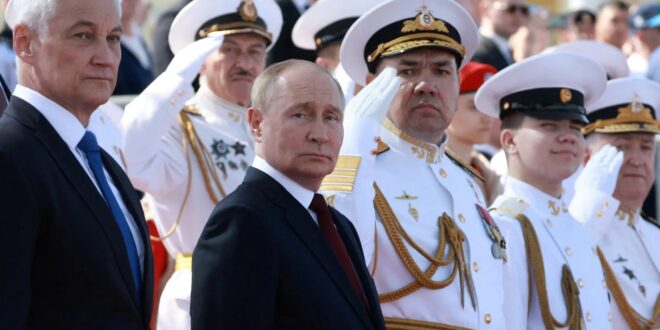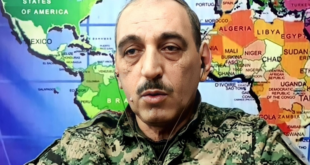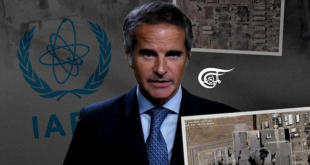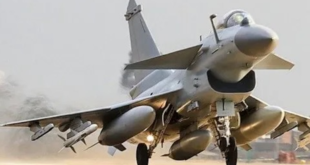The West Can’t Change His Calculus—It Can Only Wait Him Out
Two and a half years after Russia invaded Ukraine, the United States’ strategy for ending the war remains the same: impose enough costs on Russia that its president, Vladimir Putin, will decide that he has no choice but to halt the conflict. In an effort to change his cost-benefit calculus, Washington has tried to find the sweet spot between supporting Ukraine and punishing Russia on the one hand, and reducing the risks of escalation on the other. As rational as this approach may appear, it rests on a faulty assumption: that Putin’s mind can be changed.
The evidence suggests that on Ukraine, Putin simply is not persuadable; he is all in. For him, preventing Ukraine from becoming a bastion that the West can use to threaten Russia is a strategic necessity. He has taken personal responsibility for achieving that outcome and likely judges it as worth nearly any cost. Trying to coerce him into giving up is a fruitless exercise that just wastes lives and resources.
There is only one viable option for ending the war in Ukraine on terms acceptable to the West and Kyiv: waiting Putin out. Under this approach, the United States would hold the line in Ukraine and maintain sanctions against Russia while minimizing the level of fighting and amount of resources expended until Putin dies or otherwise leaves office. Only then will there be a chance for a lasting peace in Ukraine.
PUTIN THE OPPORTUNIST?
When Putin ordered the invasion, it was a war of choice. There was no urgent security threat to Russia that necessitated a large-scale invasion of its neighbor. And it was distinctly Putin’s choice. Both William Burns, the director of the CIA, and Eric Green, the National Security Council’s senior director for Russia at the time, have noted how out of the loop other Russian officials seemed to be about Putin’s decision. Even at Putin’s stage-managed, televised meeting of his top security officials on the eve of the invasion, some participants didn’t seem to know exactly what to say. Russian elites eventually lined up behind him, but before February 2022, very few were pushing for a confrontation that would cost Russia so much and shatter relations with the West.
Because it is a war of choice, Putin has the power to stop it. Recognizing that the gambit proved to be harder than he anticipated, he could decide to cut his losses. The war is not existential for Russia, even if he has cast it that way rhetorically. Withdrawing Russian forces from Ukraine wouldn’t threaten the existence of the Russian state, nor would it likely even threaten his own rule. Putin has made sure that no potential successors have appeared on the horizon. The two who came closest to challenging him—the opposition leader Alexei Navalny and the mutineer Yevgeny Prigozhin—are now dead. The Kremlin has decades of experience shaping domestic narratives to bolster Putin. He could easily declare victory in Ukraine and launch an accompanying information campaign to justify his about-face.
But while Putin has the power to stop the war, would he ever be willing to do so? U.S. policymakers have largely answered that question in the affirmative, contending that with enough pressure, he could be forced to withdraw troops from Ukraine or at least negotiate a cease-fire. To change his calculus, Washington and its allies have imposed sweeping economic sanctions on Russia, given Ukraine military equipment and intelligence support, and isolated Moscow on the global stage.
Underneath this policy lies a belief that Putin is fundamentally an opportunist. He probes forward, and when he discovers weakness, he advances, but when he is met with strength, he withdraws. According to this view, Putin’s assault on Ukraine was driven by both his imperial ambitions and his perception of weakness in the West and in Ukraine. In President Joe Biden’s words, Putin has a “craven lust for land and power” and expected that after Russian forces invaded Ukraine, “NATO would fracture and divide.” If that is the diagnosis, then the right prescription is to show strength and resilience. Raise the costs of the war high enough, and he will eventually conclude that his opportunism isn’t paying off.
A SENSE OF INSECURITY
But Putin is not an opportunist, at least not on Ukraine. His most prominent international moves have not been opportunistic ploys to gain an advantage so much as preventive efforts to forestall perceived losses or retaliate against perceived provocations. Russia’s military action in Georgia in 2008 was both a response to that country’s attack on the separatist region of South Ossetia and an effort to avoid losing control of a territory it considered a point of leverage that could prevent Georgia’s integration with the West. When Putin seized Crimea in 2014, he worried about the loss of Russia’s naval base there. When he intervened in Syria in 2015, he worried about the overthrow of Bashar al-Assad, a Russia-friendly leader. And when he interfered in the 2016 U.S. presidential election, he was responding to what he saw as U.S. efforts to undermine his position in Russia—namely, the United States’ public criticism of Russia’s elections in 2011–12 and the Panama Papers’ exposé of the secret financial dealings of his cronies in the spring of 2016.
If opportunism is motivating Putin in Ukraine—if the gambit is the product of his imperial avarice to gain Russian control of the country whenever the possibility presented itself—then his decidedly nonopportunistic approach to Ukraine from 2014 to 2021 needs to be explained. After Russia’s seizure of Crimea in March and April 2014, the Ukrainian government was in disarray. Yet rather than moving aggressively to seize additional territory, Putin chose to launch a low-level insurgency in eastern Ukraine that could be used as a bargaining chip to limit Kyiv’s foreign policy options. In September 2014, after Russian forces dealt a devastating defeat to Ukrainian forces in the city of Ilovaisk, Moscow probably could have advanced farther along the coast of the Sea of Azov, creating a land corridor from Crimea to Russia. Yet Putin instead opted for a political settlement, agreeing to the Minsk protocol.
Even after U.S. President Donald Trump took office, when it became clear that Washington was not inclined to help Kyiv, Putin still held back from launching a broader military attack or making any other attempt to expand Russian influence in Ukraine. Such missed chances sit uncomfortably alongside a view of Putin as a master opportunist.
The evidence suggests that on Ukraine, Putin simply is not persuadable; he is all in.
Rather than an opportunistic war of aggression, the assault on Ukraine is better understood as an unjust preventive war launched to stop what Putin saw as a future security threat to Russia. In Putin’s view, Ukraine was turning into an anti-Russian state that, if not stopped, could be used by the West to undermine Russia’s domestic cohesion and host NATO forces that would threaten Russia itself. On some level, U.S. officials seem to understand this. As Avril Haines, the director of national intelligence, has said, “He saw Ukraine inexorably moving towards the West and towards NATO and away from Russia.”
While the invasion was not a crime of opportunity, it was a surprisingly risky move for Putin. He has tended to be risk-averse internationally, making calculated moves and minimizing the commitment of Russian resources. At just several thousand troops, Russia’s deployment to Syria has remained relatively small and mostly reliant on the Russian air force. When his fellow autocrat Venezuelan President Nicolás Maduro seemed to be on the verge of overthrow in 2019, Putin deployed just a few hundred soldiers to help keep him in office. The war in Ukraine, by contrast, has cost Russia more than 100,000 soldiers’ lives and done untold damage to its economy and international standing.
That the war is so out of character with Putin’s normal risk calculus suggests that he made a strategic decision about Ukraine from which he is unwilling to back away. His decision to send the bulk of Russia’s army into Ukraine in 2022, and then mobilize more forces when his initial attack failed, demonstrates that he considers the war too important to fail. And for all the costs of his decision to invade, Putin likely thinks that the costs of inaction would have been higher—namely, that Russia would have been unable to prevent the emergence of a Western-aligned Ukraine that could serve as a springboard for a “color revolution” against Russia itself. If Putin doesn’t succeed now, he thinks, Russia is destined to incur those same costs. Given that this is likely how Putin is weighing the scenarios before him, Western pressure is unlikely to come anywhere close to coercing him into changing his mind and ending the war on terms acceptable to Kyiv and Washington.
THIS IS HOW IT ENDS
If Putin is unwilling to halt his assault on Ukraine, then the war can end in only one of two ways: either because Russia has lost the ability to continue its campaign or because Putin is no longer in power.
Bringing about the first outcome, by degrading Russia’s capabilities, is unrealistic. With Putin committed to the war and able to continue throwing soldiers and resources into the fight, the Russian military is unlikely to collapse. Defeating Putin on the ground in Ukraine would require a vast increase in munitions, but only in 2025 will the United States begin increasing production of necessary artillery shells, and even that uptick will not be enough to meet Ukraine’s battlefield requirements—to say nothing of the air defenses Ukraine could use. Ukraine will also need to continue sending soldiers into battle, and while the West can help train them, Western countries are not willing to commit their own troops. Adding to the difficulty, as over two years of war have shown, larger offensives are extremely difficult in the face of prepared defenses, especially now that drones and other surveillance technologies reduce the element of surprise for both sides.
That leaves the second route to ending the war: Putin’s exit from the Kremlin. Attempting to accelerate this process might look appealing, but it is an impractical idea. For decades, Washington has shown little ability to successfully manipulate Russian politics; trying to do so now would represent the triumph of hope over experience. Moreover, although Putin probably already thinks the United States is bent on ousting him, if it actually started taking steps to do so, he would very likely notice the change and see it as an escalation. In response, he might intensify Russian efforts to sow chaos in American society.
Given those risks, the best approach for Washington is to play the long game and wait for Putin to leave. It’s possible he may step down voluntarily or be pushed out; what is certain is that, at some point, he will die. Only once he is no longer in power can the real work of permanently resolving the war in Ukraine start.
PLAYING FOR TIME
Until then, Washington should focus on helping Ukraine hold the line and preventing further Russian military advances. It should continue to impose economic and diplomatic costs on Moscow but not expect them to have much effect; the main purpose of such pressure is to send the right message to U.S. allies and hold a point of leverage in reserve for a post-Putin Russia, all while avoiding domestic criticism. At the same time, Washington should husband its resources, expending them as efficiently as possible and convincing Kyiv to avoid large, wasteful offensives. Even Kyiv’s successful offensives to date—including the surprise attack into Russia’s Kursk region last month—have had little effect on the overall course of the conflict. It remains a war of attrition with no sign of a coming breakthrough for Ukraine.
When the Kursk offensive dissipates and Kyiv manages to arrest Russia’s progress in Donetsk, Washington should also support a cease-fire that halts the fighting. Although Putin could of course break any agreement, the benefits of a cease-fire outweigh the risks. A cease-fire would allow Ukraine to consolidate its defenses and train more soldiers, and the West could hedge its bets by continuing to supply the country with weapons. Most important, a cease-fire would prevent more soldiers and civilians from dying in a war that has no realistic end until Putin is gone.
When Putin does leave, however, Washington needs to be ready with a plan—one that not only resolves the war between Ukraine and Russia but also creates a positive framework for European security that eases military tensions, reduces the risk of conflict, and offers a vision that new Russian leaders in Moscow can buy into. That will require bold leadership, assertive diplomacy, and a willingness to compromise—in Moscow, Kyiv, Brussels, and Washington.
Since the invasion, the United States’ strategy toward the war in Ukraine has been characterized by wishful thinking. If only Washington can impose enough costs on Putin, it can convince him to halt the war in Ukraine. If only it can send enough weapons to Ukraine, Kyiv can push Russian forces out. After two and a half years, it should be clear that neither outcome is in the offing. The best approach is to play for time—holding the line in Ukraine, minimizing the costs for the United States, and preparing for the day Putin eventually leaves. This is an admittedly unsatisfying and politically unpalatable approach. But it is the only realistic option.
 Eurasia Press & News
Eurasia Press & News




